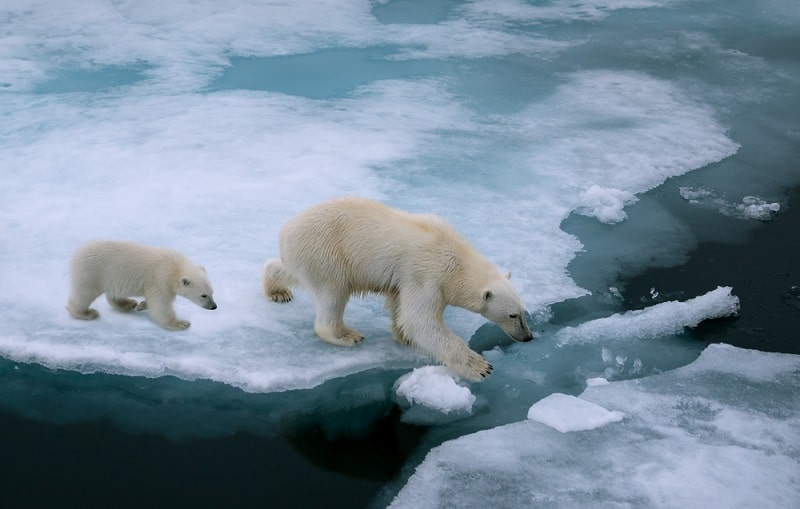Following a stormy winter, temperature influx, and weather patterns consistent with climate change, the Bering Sea measured at only 10 percent of its usual ice level by Spring 2022.
The global effects associated with extreme changes to the Bering Sea are a direct result of climate change.
For decades, experts have warned against the catastrophic effects expected to follow the gradual “warming” of the Arctic—referring to the phenomenon formerly dubbed global warming, now known as climate change.
Walt Meier, a scientist at the National Snow and Ice Data Center, comments on the grave severity of the situation, stating, “It’s the end of April, and basically the Bering Sea is ice-free when normally there would be more than 500,000 square kilometers of ice.”
What Does An “Ice-Free” Bering Sea Mean For Alaska—And for Our Planet?
To fully understand the consequences of an ice-free Bering Sea, it’s necessary to grasp both the immediate, as well global, imminent effects of climate change.
Extreme changes to the Bering Sea have, and will continue to result in severe weather changes, land erosion, and destruction of human habitats.
The most immediate effects of the melting sea are witnessed among Alaskan coastal villages — and will span the length of the globe.
Scientists have predicted the displacement of Alaska natives as a result of climate change, with experts suggesting the implementation of a displacement fund to assist indigenous people facing the aftermath of the melting Bering Sea and rising temperatures.
In addition, changes to the Bering Sea have compromised the traditional hunting practices of Alaska’s indigenous peoples, posing obstacles to ice fishing and whale hunting.
As if impending an environmental catastrophe weren’t troublesome, the very foundation of homes and businesses are on shaky ground as rising temperatures contribute to melting permafrost — essentially melting the supporting foundation of buildings from underneath the local inhabitants’ feet.
The Devastating Impact On Alaska’s Coastal Communities
Extending to Alaska’s coastal communities, devastation among Alaskans is already widespread. As if melting sea ice weren’t threatening as a single contributing factor, the damage incurred by the lack of protection typically provided by sea ice and particularly by shore-fast ice has produced devastating results.
Shorefast ice functions as a barrier from flooding and land erosion. Its absence as a result of the Bering’s melted sea ice has resulted in power outages, flooding, property damage, and displacement among Alaska’s coastal communities. Frequent storms—in part a result of already grim global warming-related weather patterns—further contributed to the lack of shore-fast and sea ice.
The Future Of Alaska’s Fish Stock Is Uncertain
Alaska natives aren’t the only inhabitants of the state already facing, and expected to endure, devastating consequences as a direct result of the ice-free Bering Sea.
Historically, the Southeastern border of the Bering Sea has been monitored more carefully by weather scientists than the Northern border, due to its more abundant presence of fish stock and fisheries.
For much of the recorded history of the sea’s temperature changes, an effective barrier between the northern and southern ends was in place as a result of the northern Bering Sea’s ice shield.
Today, the natural barrier between the two ends of the Bering Sea has dissipated, and fish stock migrates freely throughout the waters.
The effects of a now borderless Bering Sea are uncertain.
Currently, the fish stock that migrates to the northern end of the sea faces a high mortality rate, encountering death before they can provide scientists with answers regarding their future behavior.
The Albedo Effect
Further compounding the far-reaching effects of a melting Bering Sea, is a phenomenon known as the Albedo Effect.
In a nutshell, the Albedo effect accelerates global warming by causing ocean water to absorb heat from the sun that would otherwise be reflected back into space by frozen surface ice.
The Albedo effect is the result of the same weather event witnessed by scorching desert sun reflected on black clothing — a primary reason inhabitants of desert regions opt for white clothing to stay cool — and a concerning implication for melting glaciers and polar ice caps around the globe.
Emerging research indicates that the Albedo Effect is responsible for about 25 percent of the earth’s global warming.
The Threat Of Rising Sea Levels
Speaking of glaciers, the effects of rising sea levels resulting from Greenland’s massive frozen ice sheets is just beginning.
So far, Greenland’s melting glaciers have contributed to only 4.5 percent of the earth’s rising sea levels.
The concern surrounding Greenland’s ice sheets is related to their mammoth proportion, spanning about three times the size of the entire state of Texas.
As glacier melt rate accelerates, far-reaching effects are expected to reach coastal areas in the United States, displacing resident of Florida, New Jersey, and Maryland, all of whom are experiencing an increase in flooding.
The Astonishing Rate Of Sea Ice Melt Across The Globe
Not to be understated when discussing the effects of melting Bering Sea ice, is the astonishing rate at which it’s occurring.
Dating back to the earliest record history of sea levels and ice sheets, scientists have monitored the rate of melting ice among the Arctic’s frozen glaciers.
As a result of these historical records, researchers are able to predict trends, patterns, and rates at which glaciers and permafrost melt without posing a threat to the environment.
The massive loss of sea ice witnessed in the Bering Sea occurred in just eight days, a figure gravely concerning to scientists and researchers working in various disciplines.
Loss of sea ice is occurring in neighboring Greenland and Barents seas, as well.
The only year to demonstrate the same loss of sea ice on record was 1989—a year in which sea levels were restored the following season by normal winter weather patterns—not the case witnessed in 2022’s winter sea ice decline.
The Perfect Storm
Among the individual factors contributing to climate change as a direct result of melting Bering Sea ice, experts fear a devastating compounding of numerous weather factors to accelerate and worsen the wide-reaching effects.
Storms, rising ocean temperatures, and chaotic weather patterns all associated with the effects of global warming are expected to impact further the grave situation unfolding in the Arctic.
Recorded sea temperatures over winter 2022 came in at a high of 21 degrees Fahrenheit over the average, and are expected to rise.
Although scientists attribute these volatile weather patterns in part to random circumstances, experts agree that global warming played a significant role and will continue to impact sea temperatures and weather behavior in the Arctic negatively.
Global Effects Of Lost Bering Sea Ice
Taking center stage are the global effects that will persist from the Bering’s melting sea ice, an all too imminent disaster.
As polar ice caps melt, sea ice declines, and chaotic weather patterns associated with the already dire consequences of global warming continue while worsening weather patterns and results are expected to unfold.
Experts predict that existing factors that already pose a threat to the environment will see a dramatic rise in the Northern hemisphere, including:
- Greenhouse gas emissions
- Heat waves
- Major flooding capable of displacing homes and businesses
Ultimately, scientists are concerned with the direction of the earth’s jet stream, a robust wind source that navigates weather systems.
Disruptions to the jet stream resulting in unpredictable weather patterns, droughts, and wildfires.
Extreme weather, including the increasing presence of bitterly cold winters and scorching summers, is also the result of disruption to the jet stream in the Northern hemisphere.
Unchecked, carbon and greenhouse gas emissions will contribute to the destruction of the earth’s ecosystem, as fossil fuels destroy the ozone layer.
Other factors, deemed by scientists as “wildcards,” play an unexpected role in further contributing to the severely disrupted jet stream.
Among these so-called wildcards is the presence of aerosol emissions, a previously known hazard to the ozone layer.
Emerging research indicates that aerosol emissions may actually reduce the effects of greenhouse gas emissions by cooling the powerful wind forces behind jet stream formation.
As a result of environmental regulations currently in place, aerosol emissions are expected to decline, potentially worsening the threat of greenhouse gas.
Looking Ahead: The Future Of Our Planet
Based on the current circumstances facing planet Earth, scientists predict a worsening manifestation of already existing contributing factors to climate change including disruptions to the jet stream, melting sea ice, rising sea levels, and Arctic warming.
Without a drastic reduction in greenhouse gas emissions, fossil fuel pollution, and our collective carbon footprint, climate change is expected to displace communities and permanently alter the earth’s landscape within a few short generations.
While the impending series of events is dire, experts encourage the adoption of harm reduction measures, and environmentally conscious lifestyle modifications to potentially alter the course of climate change.
Reducing your carbon footprint, taking actionable steps toward sustainable living, and helping to change the environment around you with immediate behavior and lifestyle changes go a long way in preserving human life on Earth.






